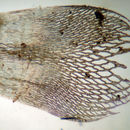Comments
provided by eFloras
Sporophytes are uncommon. Sphagnum lindbergii is normally easily distinguished from other carpet-forming species of sect. Cuspidata by its large, strongly lacerate stem leaf and dark brown to black stem. Sexual condition is taken from from L. I. Savicz-Lubitzkaya and Z. N. Smirnova (1968).
- license
- cc-by-nc-sa-3.0
- copyright
- Missouri Botanical Garden, 4344 Shaw Boulevard, St. Louis, MO, 63110 USA
Description
provided by eFloras
Plants moderate-sized to large, moderately densely branched; green to brown, often bluish tinged and/or shiny when dry; capitulum flattopped with a conspicuous terminal bud. Stems dark brown; superficial cortex of 2-4 layers of enlarged, thin-walled cells. Stem leaves lingulate-spatulate, large, 1.3-1.6 mm; appressed to stem; apex very broad and lacerate; hyaline cells efibrillose and aporose, often septate. Branches strongly 5-ranked and straight. Branch fascicles with 2 spreading and 2 pendent branches, leaves not much elongated at distal end. Branch stems green, with cortex enlarged with retort cells. Branch leaves ovate-lanceolate, 1.5-3 mm; straight to slightly subsecund; imbricate to somewhat reflexed and not undulate; margins entire; hyaline cells long and narrow, length to width ca. 10:1 on convex surface with 1 or more small pores in the cell ends and angles and often with numerous pseudopores along the margins, on concave surface with large round wall thinnings on the cell ends and angles; chlorophyllous cells triangular to trapezoidal in transverse section, apex often exposed on concave surface. Sexual condition monoicous or dioicous. Spores 22-34 µm; both surfaces smooth, apparent ridged border on proximal surface; proximal laesura more than 0.5 spore radius.
- license
- cc-by-nc-sa-3.0
- copyright
- Missouri Botanical Garden, 4344 Shaw Boulevard, St. Louis, MO, 63110 USA
Comprehensive Description
provided by North American Flora
Sphagnum lindbergii Schimp. Versuch Torfm. 67.. 1858
Plants more or less robust, yellowish or generally considerably tinged with brown. Woodcylinder brown; cortical cells of the stem in 2-4 layers, very large and thin-walled, the outer cells quadrilateral, without pores: stem-leaves large, broadly spatulate, strongly auricled at the base, widely lacerate at the truncate apex, with a border of narrow cells at the side, wider toward the base; hyaline cells wide in the apex, narrowing toward the base, the upper cells sometimes divided, in the basal part more or less fibrillose, the membrane resorbed on both surfaces in the apical part of the leaf, the gaps reduced and disappearing downward: branches in fascicles of 4 or 5, 2 spreading, their cortical cells in a single layer, the retort-cells with an inconspicuous neck: branch-leaves slightly undulate when dry, tending to be five-ranked when moist, sometimes slightly subsecund, ovate-lanceolate to lanceolate, involute especially toward the toothed apex, the border entire, of 3-5 rows of narrow cells; hyaline cells fibrillose, narrowly rhomboidal, in the basal portion 12-15 times as long as wide, shorter above to about 8 times near the apex, the pores of the inner surface few in the apical part, in the ends and corners of the cells, up to 3-4 per cell, on the outer surface the pores very small, ringed, in the ends and comers, not exceeding 4 per cell, with pseudopores also in the apical cells: chlorophylcells in section triangular with curving legs to trapezoidal or rarely truncately elliptic, exposed on both surfaces or only on the outer one, the lumen elliptic to triangular, central or slightly nearer the outer surface; hyaline cells but slightly convex on either surface, more so on the inner, where up to one fifth of the diameter of the cell.
Dioicous or monoicous. Antheridia borne on undifferentiated spreading or pendent branches. Fruiting branches short; perichaetial leaves spatulate, the lower part consisting of uniform narrow cells with pitted walls, in the upper one third or one half with both kinds of cells, the hyaline cells with longitudinal membrane-pleats especially on the outer surface, passing to elongate gaps in the upper cells, the apex irregularly lacerate as in the stem-leaves: spores greenish-yellow, 24-28 m in diameter, very slightly granular-roughened. Type locality: Lapland.
Distribution: Greenland; Labrador southward to New Hampshire (Mt. Monroe) and New York (Mt. Whiteface); Vancouver Island to Alaska; also in northern Europe and reported from Asia.
- bibliographic citation
- Albert LeRoy Andrews, Elizabeth Gertrude Britton, Julia Titus Emerson. 1961. SPHAGNALES-BRYALES; SPHAGNACEAE; ANDREAEACEAE, ARCHIDIACEAE, BRUCHIACEAE, DITRICHACEAE, BRYOXIPHIACEAE, SELIGERIACEAE. North American flora. vol 15(1). New York Botanical Garden, New York, NY

